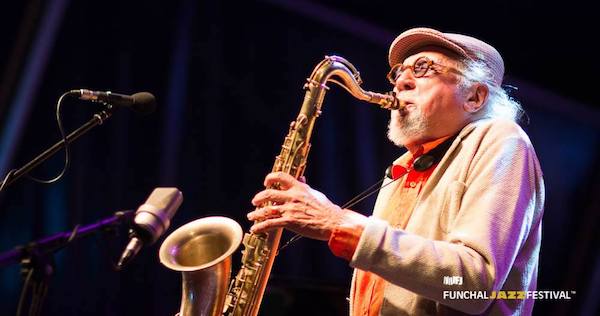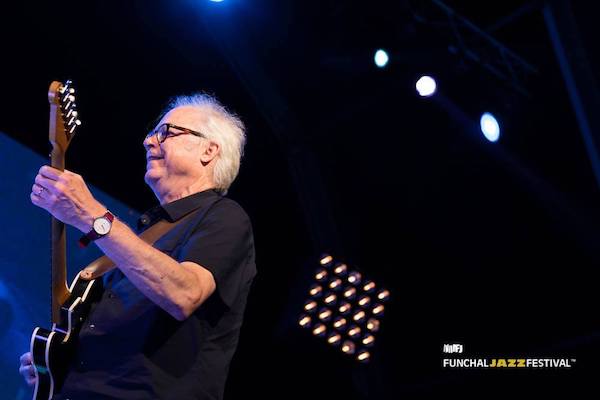Apr 2, 2024 12:59 PM
Saxophonist, Sonic Explorer Casey Benjamin Dies at 45
Casey Benjamin, the alto saxophonist, vocalist, keyboardist and producer who stamped his distinctive sounds on the…

Charles Lloyd performs during the Funchal Jazz Festival in Madeira, Portugal, on July 15.
(Photo: Courtesy Funchal Jazz Festival/facebook.com/funchaljazz)The 18th annual Funchal Jazz Festival, which transpired July 13–15 in the capital city of Madeira, a Portuguese island situated about 250 miles due west of Morocco, was a well-curated event, artistic-directed by Paolo Barbosa, a local high school biology teacher and jazz history professor who understands how the personal histories that fuel the narratives portrayed by world-class improvisers can intersect.
The young Portuguese button-accordion virtuoso João Barradas with guest saxophonist Greg Osby played opposite the ever-young old masters who comprise Saxophone Summit (with Osby) on July 13. Rudy Royston’s trio with Jon Irabagon on tenor and sopranino saxophone and Yasushi Nakamura on bass played a masterful set opposite Kurt Rosenwinkel’s newly formed Caipi band on July 14.
The festival concluded on July 15 with a program at which the Bill Frisell Trio, with long-standing bandmates Tony Scherr on bass and Kenny Wollesen on drums, played opposite the Charles Lloyd Quartet, comprising the think-as-one rhythm section of Gerald Clayton (piano), Reuben Rogers (bass) and Eric Harland (drums).
For the 9:30 set, Frisell’s trio, which has toured extensively in 2017, played a melody-rich, almost continuous set of nine of the leader’s Americana-oriented originals—among them “Levees,” “Rambles,” “Blues For Los Angeles” and “Small Town”—and, as an encore, Burt Bacharach’s “What The World Needs Now Is Love.” They displayed the relaxed panache of three old friends engaging in sonic conversation on such topics as Western noir, Thelonious Monk, surf rock and the blues.

Bill Frisell performs at the Funchal Jazz Festival on July 15. (Photo: Courtesy Funchal Jazz Festival)
Frisell deliberately wended his way through pristinely executed guitar solos, grounded impeccably by Scherr and cosigned ebulliently by Wollesen, who interpolated textural commentary into his flow, occasionally emphasizing a beat or a phrase on an electronic drum pad positioned to his right from which he elicited a timbral range spanning bell sounds to skronk.
Frisell had agreed to play a tune with Lloyd, with whom he’d toured in 2014, 2015 and 2016 as part of Charles Lloyd and the Marvels, a group comprising Harland, Rogers and steel guitarist Greg Leisz. Following Lloyd’s opening cadenza and several choruses on “Defiant,” Frisell enfolded his solo within the band’s ambiance, as though he’d been touring with them for a month. It was almost midnight, and the 66-year-old guitarist had a 4 a.m. lobby call, but, to the delight of the several thousand attendees in Santa Catarina Gardens, he remained on stage for the remaining 75 minutes, projecting his unique sound in both the soloistic and comping functions while offering a master class in creating a space of his own.
Clayton played a succession of spiky, speculative solos that revealed his harmonic acumen, nuanced touch, orchestral conception and rhythmic surefootedness at all tempos. Rogers inexorably bulwarked the flow, and Harland morphed from one fresh, imaginatively textured groove pattern to the next.
Lloyd, 79, had arrived in Funchal early to acclimate and rest. That decision paid off, not only in his impeccable execution on tenor sax of an “impossible” rapid descending tag figure on the forceful “Passin’ Thru” and his soulful flute solo on “Tagore,” but in the vulnerable, wisps-of-light tonal quality of his tenor solo on “Monk’s Mood” and the purity of his sound on the encore, Cuban filin composer Silvio Rodriguez’s “Rabo De Nube,” which segued into the iconic Mexican song “La Llorona,” climaxing with a closing cadenza on which Lloyd evoked a cry-in-the-wilderness voice, before he ended the performance with exultant whoops.
To read a review of the first two nights of the Funchal Jazz Festival, including Kurt Rosenwinkel’s performance, click here. DB

Benjamin possessed a fluid, round sound on the alto saxophone, and he was often most recognizable by the layers of electronic effects that he put onto the instrument.
Apr 2, 2024 12:59 PM
Casey Benjamin, the alto saxophonist, vocalist, keyboardist and producer who stamped his distinctive sounds on the…

“He’s constructing intelligent musical sentences that connect seamlessly, which is the most important part of linear playing,” Charles McPherson said of alto saxophonist Sonny Red.
Feb 27, 2024 1:40 PM
“I might not have felt this way 30 to 40 years ago, but I’ve reached a point where I can hear value in what people…

Albert “Tootie” Heath (1935–2024) followed in the tradition of drummer Kenny Clarke, his idol.
Apr 5, 2024 10:28 AM
Albert “Tootie” Heath, a drummer of impeccable taste and time who was the youngest of three jazz-legend brothers…

“Both of us are quite grounded in the craft, the tradition and the harmonic sense,” Rosenwinkel said of his experience playing with Allen. “Yet I felt we shared something mystical as well.”
Mar 12, 2024 11:42 AM
“There are a few musicians you hear where, as somebody once said, the molecules in the room change. Geri was one of…

Larry Goldings’ versatility keeps him in high demand as a leader, collaborator and sideman.
Feb 21, 2024 10:45 AM
Are you having any fun? Larry Goldings certainly is. Consider just two recent examples:
Scene 1: “If anyone had…